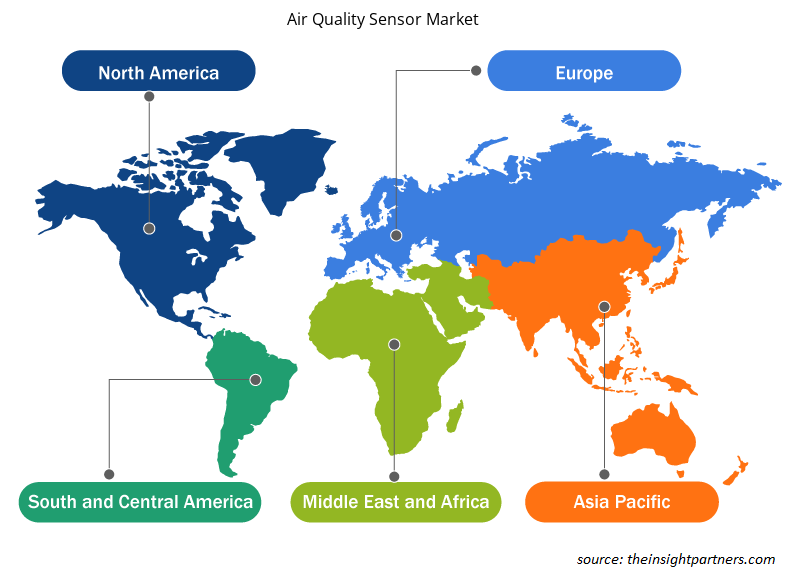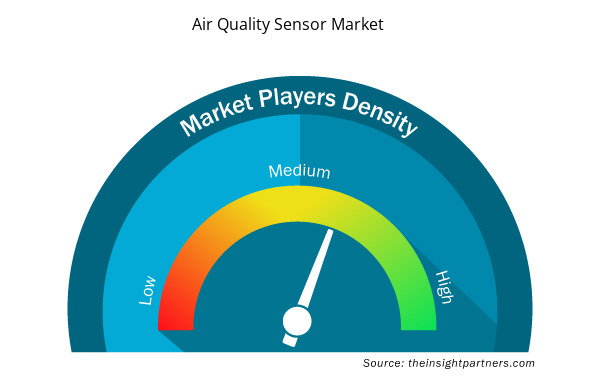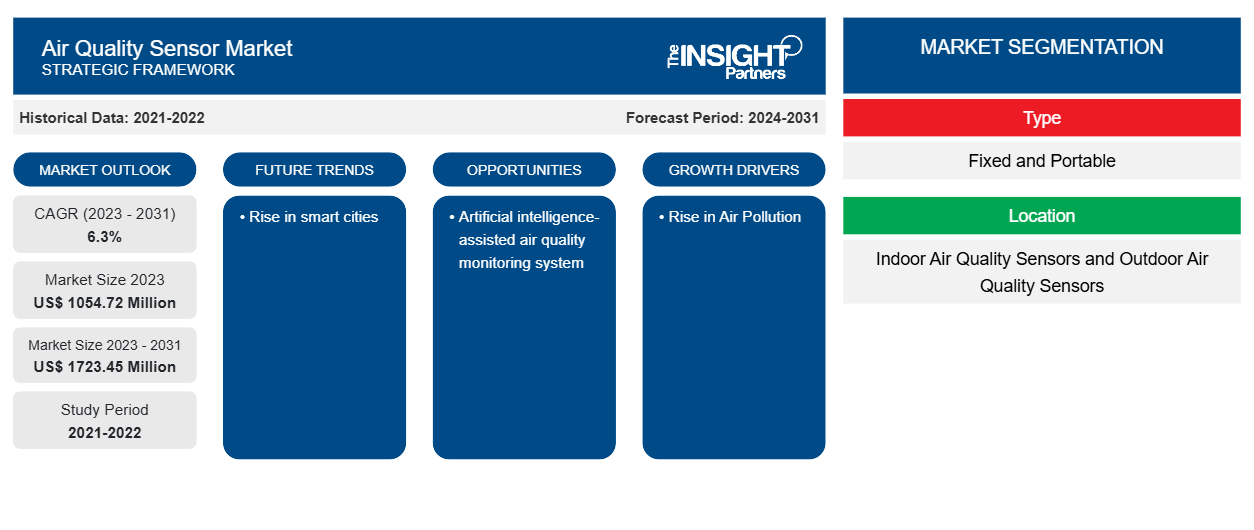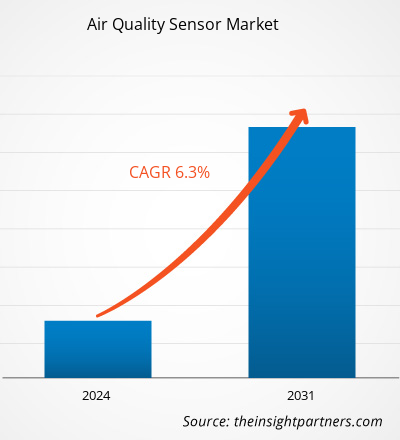空気質センサー市場規模は、2023年の10億5,472万米ドルから2031年には17億2,345万米ドルに達すると予測されています。市場は2023年から2031年にかけて6.3%のCAGRを記録すると予想されています。大気汚染の拡大と政府の持続可能性への重点は、空気質センサー市場の主要なトレンドであり続けると思われます。
空気質センサー市場分析
環境への懸念の高まりと、空気の質を監視する政府による厳格な規制により、空気質センサー市場の導入が進んでいます。きれいな空気の重要性と空気感染による病気の欠点に関する認識の高まりにより、さまざまな業界での導入が進んでいます。環境に優しい産業の発展に向けた政府の取り組みにより、市場の成長がさらに促進されています。
空気質センサー市場の概要
空気質センサーは、空気中の汚染物質の濃度を測定する装置です。空気清浄機や外気清浄システムに不可欠なコンポーネントです。空気質センサーは通常、粒子状物質 (pm1、pm2.5、pm10 など)、ガス (オゾン、一酸化炭素、二酸化炭素、メタン、ホルムアルデヒドなど)、および一部の環境指標 (温度、湿度、紫外線、照度など) を測定できます。空気質センサーは、光学的、電気的、熱的、およびその他の方法を使用して、空気中のガスおよび粒子状物質指標を検出します。
要件に合わせてレポートをカスタマイズする
このレポートの一部、国レベルの分析、Excelデータパックなど、あらゆるレポートを無料でカスタマイズできます。また、スタートアップや大学向けのお得なオファーや割引もご利用いただけます。
- このレポートの主要な市場動向を入手してください。この無料サンプルには、市場動向から見積もりや予測に至るまでのデータ分析が含まれます。
空気質センサー市場の推進要因と機会
大気汚染の増加が市場に有利に働く
工業化の進展により、粒子状物質などの毒素が加わり、大気汚染が増加しています。多くの国の政府は、それぞれの地域で厳しい規制を実施し、工業地帯から発生する大気汚染を軽減するためのさまざまな対策を考案しています。さらに、米国、インド、カナダを含む多くの国の政府は、汚染レベルを管理および追跡するために、発電所、石油・ガス、自動車に空気質センサーを設置しています。屋外の空気質モニタリングを使用することで、工場は工業ユニット周辺の空気質指数を監視し、排出率を制御できます。
空気質センサーの利点
世界中で環境への懸念が高まる中、環境への影響を最小限に抑えるために、空気の質を継続的に監視し、特定の措置を講じる必要があります。そのため、空気質センシング技術の需要は、それらが提供するいくつかの利点により、勢いを増しています。屋内/屋外の空気の状態をリアルタイムで監視することで、健康的な環境を作り出すのに役立ちます。空気質センサーは簡単に設置でき、モバイルやコンピューターに簡単に接続して、空気質の結果を表示します。温度、気圧、湿度など、さまざまなパラメーターを検出できます。継続的な技術進歩により、これらのセンサーの精度が向上し、政府機関や学術機関、商業および住宅ユーザー、石油化学産業、発電所、製薬業界、スマートシティ当局など、幅広い業界の複数のプレーヤーからの需要につながっています。したがって、この需要に応えるために、市場プレーヤーは空気質センサー市場を牽引するソリューションを立ち上げています。たとえば、2021年6月、ヴァイサラは、コミュニティの生活の質、安全性、効率性、持続可能性を向上させる監視ソリューションを補完する世界クラスの空気質センサーを発売しました。
空気質センサー市場レポートのセグメンテーション分析
空気質センサー市場分析の導出に貢献した主要なセグメントは、タイプ、場所、およびエンドユーザーです。
- タイプに基づいて、市場は固定式とポータブル式に分かれています。固定式空港セグメントは2023年に大きな市場シェアを占めました。
- 場所別に見ると、市場は屋内空気質センサーと屋外空気質センサーに分類されます。屋外空気質センサーセグメントは、2023年に市場で最大のシェアを占めました。
- エンドユーザー別に見ると、市場は政府機関および学術機関、商業および住宅ユーザー、石油化学産業、発電所、製薬業界、スマートシティ当局、その他に分類されています。政府機関および学術機関セグメントは、2023年に市場で最大のシェアを占めました。
地域別空気質センサー市場シェア分析
空気質センサー市場レポートの地理的範囲は、主に北米、アジア太平洋、ヨーロッパ、中東およびアフリカ、南米/中南米の 5 つの地域に分かれています。
収益面では、アジア太平洋地域が2023年に最大の空気質センサー市場シェアを占めました。この地域は、インド、日本、中国などの先進国と発展途上国で構成されており、清潔で安全な環境を促進するためのこれらのセンサーの需要を促進しています。これらのセンサーを使用する利点に関する認識の高まりが市場の成長を後押ししています。さらに、この地域の政府機関はこれらのセンサーの開発に注力しており、それが市場の成長をさらに促進しています。たとえば、2023年1月、MeitYはMeitYが支援するプロジェクトで開発された空気質監視システム技術(AI-AQMS v1.0)を発売しました。コルカタの高度コンピューティング開発センター (C-DAC) は、TeXMIN、ISM、ダンバードと共同で、「農業と環境における電子機器と ICT の応用に関する国家プログラム (AgriEnIcs)」の一環として、環境の空気質を継続的に分析するために、PM 1.0、PM 2.5、PM 10.0、SO2、NO2、CO、O2、周囲温度、相対湿度などのパラメータを含む環境汚染物質を監視する屋外空気質監視ステーションを開発しました。
空気質センサー市場の地域別分析
予測期間を通じて空気質センサー市場に影響を与える地域的な傾向と要因は、Insight Partners のアナリストによって徹底的に説明されています。このセクションでは、北米、ヨーロッパ、アジア太平洋、中東、アフリカ、南米、中米にわたる空気質センサー市場のセグメントと地理についても説明します。

- 空気質センサー市場の地域別データを入手
空気質センサー市場レポートの範囲
| レポート属性 | 詳細 |
|---|---|
| 2023年の市場規模 | 10億5,472万米ドル |
| 2031年までの市場規模 | 17億2,345万米ドル |
| 世界のCAGR(2023年~2031年) | 6.3% |
| 履歴データ | 2021-2022 |
| 予測期間 | 2024-2031 |
| 対象セグメント | タイプ別
|
| 対象地域と国 | 北米
|
| 市場リーダーと主要企業プロフィール |
|
空気品質センサー市場のプレーヤー密度:ビジネスダイナミクスへの影響を理解する
空気品質センサー市場は、消費者の嗜好の変化、技術の進歩、製品の利点に対する認識の高まりなどの要因により、エンドユーザーの需要が高まり、急速に成長しています。需要が高まるにつれて、企業は提供を拡大し、消費者のニーズを満たすために革新し、新たなトレンドを活用し、市場の成長をさらに促進しています。
市場プレーヤー密度とは、特定の市場または業界内で活動している企業または会社の分布を指します。これは、特定の市場スペースに、その規模または総市場価値と比較して、どれだけの競合相手 (市場プレーヤー) が存在するかを示します。
空気質センサー市場で事業を展開している主要企業は次のとおりです。
- エネルゴモニター
- メットワンインストゥルメンツ
- スエズ
- ルネサスエレクトロニクス株式会社 Electronics Corporation
- ウィンセン
- E+E
免責事項:上記の企業は、特定の順序でランク付けされていません。

- 空気品質センサー市場のトップキープレーヤーの概要を入手
空気質センサー市場のニュースと最近の動向
空気品質センサー市場は、重要な企業出版物、協会データ、データベースを含む一次調査と二次調査後の定性的および定量的データを収集することによって評価されます。以下は、市場の動向の一覧です。
- 2024 年 3 月、気候変動対策のための計測機器とインテリジェンスの世界的リーダーであるヴァイサラは、PM1、PM2.5、PM10 の幅広い検出範囲と、比類のない検出精度と効率を可能にする独自の校正システムとアルゴリズムを備えたゴールド スタンダードのコンパクト空気質センサー、Air Quality Transmitter 560 (AQT560) の発売を発表しました。(出典: Vaisala, Inc、プレスリリース、2024 年)
- リアルタイム データ ソリューションの業界リーダーである Attune は、2024 年 1 月に、最新のイノベーションである屋外空気質 (OAQ) キットを発表しました。これは、任意の場所の周囲の空気質を監視するために設計されたセンサーベースのプラットフォームです。UL-2905 認定の屋内空気質監視センサーを屋外用に再利用した OAQ キットは、さまざまな屋外空気の脅威に関する包括的なデータを提供します。マルチセンサーのプラグ アンド プレイ テクノロジーは、温度、相対湿度、揮発性有機化合物 (VOC)、粒子状物質 (PM) などの汚染物質を検出し、オペレーターに積極的な意思決定のための重要な洞察を提供します。(出典: Attune、プレス リリース、2024 年)
空気質センサー市場レポートの対象範囲と成果物
「空気質センサー市場の規模と予測(2021〜2031年)」レポートでは、以下の分野をカバーする市場の詳細な分析を提供しています。
- 対象範囲に含まれるすべての主要市場セグメントの世界、地域、国レベルでの市場規模と予測
- 市場の動向(推進要因、制約、主要な機会など)
- 今後の主な動向
- 詳細なPEST/ポーターの5つの力とSWOT分析
- 主要な市場動向、主要プレーヤー、規制、最近の市場動向を網羅した世界および地域の市場分析
- 市場集中、ヒートマップ分析、主要プレーヤー、最近の動向を網羅した業界の状況と競争分析
- 詳細な企業プロフィール
- 過去2年間の分析、基準年、CAGRによる予測(7年間)
- PEST分析とSWOT分析
- 市場規模価値/数量 - 世界、地域、国
- 業界と競争環境
- Excel データセット


- Electronic Toll Collection System Market
- Arterial Blood Gas Kits Market
- Aircraft MRO Market
- Trade Promotion Management Software Market
- Passport Reader Market
- Single-Use Negative Pressure Wound Therapy Devices Market
- Skin Tightening Market
- Rare Neurological Disease Treatment Market
- Sexual Wellness Market
- Aircraft Wire and Cable Market

Report Coverage
Revenue forecast, Company Analysis, Industry landscape, Growth factors, and Trends

Segment Covered
This text is related
to segments covered.

Regional Scope
North America, Europe, Asia Pacific, Middle East & Africa, South & Central America

Country Scope
This text is related
to country scope.
よくある質問
The global air quality sensor market was estimated to be US$ 1054.72 million in 2023 and is expected to grow at a CAGR of 6.3% during the forecast period 2023 – 2031.
Growing air pollution and government focus on sustainability are the major factors that propel the global air quality sensor market.
Artificial intelligence-assisted air quality monitoring system is anticipated to play a significant role in the global air quality sensor market in the coming years.
The key players holding majority shares in the global air quality sensor market are Energomonitor, E+E, Infineon Technologies, Siemens AG, and Honeywell International Inc.
The global air quality sensor market is expected to reach US$ 1723.45 million by 2031.
The incremental growth expected to be recorded for the global air quality sensor market during the forecast period is US$ 668.73 million.
Trends and growth analysis reports related to Electronics and Semiconductor : READ MORE..
The Insight Partners performs research in 4 major stages: Data Collection & Secondary Research, Primary Research, Data Analysis and Data Triangulation & Final Review.
- Data Collection and Secondary Research:
As a market research and consulting firm operating from a decade, we have published and advised several client across the globe. First step for any study will start with an assessment of currently available data and insights from existing reports. Further, historical and current market information is collected from Investor Presentations, Annual Reports, SEC Filings, etc., and other information related to company’s performance and market positioning are gathered from Paid Databases (Factiva, Hoovers, and Reuters) and various other publications available in public domain.
Several associations trade associates, technical forums, institutes, societies and organization are accessed to gain technical as well as market related insights through their publications such as research papers, blogs and press releases related to the studies are referred to get cues about the market. Further, white papers, journals, magazines, and other news articles published in last 3 years are scrutinized and analyzed to understand the current market trends.
- Primary Research:
The primarily interview analysis comprise of data obtained from industry participants interview and answers to survey questions gathered by in-house primary team.
For primary research, interviews are conducted with industry experts/CEOs/Marketing Managers/VPs/Subject Matter Experts from both demand and supply side to get a 360-degree view of the market. The primary team conducts several interviews based on the complexity of the markets to understand the various market trends and dynamics which makes research more credible and precise.
A typical research interview fulfils the following functions:
- Provides first-hand information on the market size, market trends, growth trends, competitive landscape, and outlook
- Validates and strengthens in-house secondary research findings
- Develops the analysis team’s expertise and market understanding
Primary research involves email interactions and telephone interviews for each market, category, segment, and sub-segment across geographies. The participants who typically take part in such a process include, but are not limited to:
- Industry participants: VPs, business development managers, market intelligence managers and national sales managers
- Outside experts: Valuation experts, research analysts and key opinion leaders specializing in the electronics and semiconductor industry.
Below is the breakup of our primary respondents by company, designation, and region:

Once we receive the confirmation from primary research sources or primary respondents, we finalize the base year market estimation and forecast the data as per the macroeconomic and microeconomic factors assessed during data collection.
- Data Analysis:
Once data is validated through both secondary as well as primary respondents, we finalize the market estimations by hypothesis formulation and factor analysis at regional and country level.
- Macro-Economic Factor Analysis:
We analyse macroeconomic indicators such the gross domestic product (GDP), increase in the demand for goods and services across industries, technological advancement, regional economic growth, governmental policies, the influence of COVID-19, PEST analysis, and other aspects. This analysis aids in setting benchmarks for various nations/regions and approximating market splits. Additionally, the general trend of the aforementioned components aid in determining the market's development possibilities.
- Country Level Data:
Various factors that are especially aligned to the country are taken into account to determine the market size for a certain area and country, including the presence of vendors, such as headquarters and offices, the country's GDP, demand patterns, and industry growth. To comprehend the market dynamics for the nation, a number of growth variables, inhibitors, application areas, and current market trends are researched. The aforementioned elements aid in determining the country's overall market's growth potential.
- Company Profile:
The “Table of Contents” is formulated by listing and analyzing more than 25 - 30 companies operating in the market ecosystem across geographies. However, we profile only 10 companies as a standard practice in our syndicate reports. These 10 companies comprise leading, emerging, and regional players. Nonetheless, our analysis is not restricted to the 10 listed companies, we also analyze other companies present in the market to develop a holistic view and understand the prevailing trends. The “Company Profiles” section in the report covers key facts, business description, products & services, financial information, SWOT analysis, and key developments. The financial information presented is extracted from the annual reports and official documents of the publicly listed companies. Upon collecting the information for the sections of respective companies, we verify them via various primary sources and then compile the data in respective company profiles. The company level information helps us in deriving the base number as well as in forecasting the market size.
- Developing Base Number:
Aggregation of sales statistics (2020-2022) and macro-economic factor, and other secondary and primary research insights are utilized to arrive at base number and related market shares for 2022. The data gaps are identified in this step and relevant market data is analyzed, collected from paid primary interviews or databases. On finalizing the base year market size, forecasts are developed on the basis of macro-economic, industry and market growth factors and company level analysis.
- Data Triangulation and Final Review:
The market findings and base year market size calculations are validated from supply as well as demand side. Demand side validations are based on macro-economic factor analysis and benchmarks for respective regions and countries. In case of supply side validations, revenues of major companies are estimated (in case not available) based on industry benchmark, approximate number of employees, product portfolio, and primary interviews revenues are gathered. Further revenue from target product/service segment is assessed to avoid overshooting of market statistics. In case of heavy deviations between supply and demand side values, all thes steps are repeated to achieve synchronization.
We follow an iterative model, wherein we share our research findings with Subject Matter Experts (SME’s) and Key Opinion Leaders (KOLs) until consensus view of the market is not formulated – this model negates any drastic deviation in the opinions of experts. Only validated and universally acceptable research findings are quoted in our reports.
We have important check points that we use to validate our research findings – which we call – data triangulation, where we validate the information, we generate from secondary sources with primary interviews and then we re-validate with our internal data bases and Subject matter experts. This comprehensive model enables us to deliver high quality, reliable data in shortest possible time.


 このレポートの無料サンプルを入手する
このレポートの無料サンプルを入手する